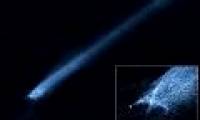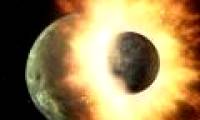
A meteorite will fly close to the earth tomorrow but not collide with our planet.

The European Atomic Research Organization (CERN) has successfully conducted experiments to create a direct collision between proton particles producing extremely large energy.

Based on an image taken by the Hubble Space Telescope, scientists believe that collisions in the universe are no longer hypotheses.

A galaxy that humans cannot see collides with the Milky Way but it retains its shape.

At a November 3 space conference in Omaha, Nebraska, the US military warned of an increased risk of collisions between satellites in the universe.

Scientists were stunned to learn that a meteorite flew nearly 14,000 kilometers from Earth last Friday but they only discovered it before 15 hours.

According to the Space site of the US aerospace agency (NASA), astronomers have taken advantage of the Spitzer space telescope to discover that two planets orbiting a young Venus,

As the sun turns into a red giant, the orbits of the planets near it will be disordered, leading to the risk of collisions between the planet and Mars and Venus.

According to new research by American scientists, a large meteorite will not be able to destroy life on earth as previously imagined.

Fragments of satellites
 A meteorite will fly close to the earth tomorrow but not collide with our planet.
A meteorite will fly close to the earth tomorrow but not collide with our planet. The European Atomic Research Organization (CERN) has successfully conducted experiments to create a direct collision between proton particles producing extremely large energy.
The European Atomic Research Organization (CERN) has successfully conducted experiments to create a direct collision between proton particles producing extremely large energy. Based on an image taken by the Hubble Space Telescope, scientists believe that collisions in the universe are no longer hypotheses.
Based on an image taken by the Hubble Space Telescope, scientists believe that collisions in the universe are no longer hypotheses. A galaxy that humans cannot see collides with the Milky Way but it retains its shape.
A galaxy that humans cannot see collides with the Milky Way but it retains its shape. At a November 3 space conference in Omaha, Nebraska, the US military warned of an increased risk of collisions between satellites in the universe.
At a November 3 space conference in Omaha, Nebraska, the US military warned of an increased risk of collisions between satellites in the universe. Scientists were stunned to learn that a meteorite flew nearly 14,000 kilometers from Earth last Friday but they only discovered it before 15 hours.
Scientists were stunned to learn that a meteorite flew nearly 14,000 kilometers from Earth last Friday but they only discovered it before 15 hours. According to the Space site of the US aerospace agency (NASA), astronomers have taken advantage of the Spitzer space telescope to discover that two planets orbiting a young Venus,
According to the Space site of the US aerospace agency (NASA), astronomers have taken advantage of the Spitzer space telescope to discover that two planets orbiting a young Venus, As the sun turns into a red giant, the orbits of the planets near it will be disordered, leading to the risk of collisions between the planet and Mars and Venus.
As the sun turns into a red giant, the orbits of the planets near it will be disordered, leading to the risk of collisions between the planet and Mars and Venus. According to new research by American scientists, a large meteorite will not be able to destroy life on earth as previously imagined.
According to new research by American scientists, a large meteorite will not be able to destroy life on earth as previously imagined. Fragments of satellites
Fragments of satellites




 NASA's 'Ninth Planet' Shows Signs of Being Friendly to Life
NASA's 'Ninth Planet' Shows Signs of Being Friendly to Life Why did American astronauts have to be quarantined when returning to Earth?
Why did American astronauts have to be quarantined when returning to Earth? China surprises the world by building a cable-stayed bridge 'above the clouds'
China surprises the world by building a cable-stayed bridge 'above the clouds' Why do women sleep less and wake up more than men?
Why do women sleep less and wake up more than men? Revealing the secret inside the stuffed animal claw machine, from there, summarizing experience to help you increase your winning rate many times over
Revealing the secret inside the stuffed animal claw machine, from there, summarizing experience to help you increase your winning rate many times over What would happen if you dug a hole through the Earth and jumped in?
What would happen if you dug a hole through the Earth and jumped in? Camera takes a photo that lasts 1,000 years
Camera takes a photo that lasts 1,000 years Was there nuclear war in ancient times?
Was there nuclear war in ancient times?